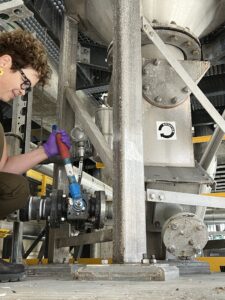Ahousaht First Nation
By Anna Agnew CWP CWWP, and Kalpna Solanki CPHI(C) BSc MBA
Chris Frank of Ahousaht, with Anna Agnew and Kalpna Solanki
What a fabulous way to begin a tour… with a thirty-minute boat ride from the government dock in Tofino to Ahousaht First Nation on Flores Island. It is the largest member of the Nuu-chah-nulth Tribal Council. Ahousaht members live across Vancouver Island, on the Mainland of BC, and even in parts of Washington State. Its administrative centre, the village of Maaqutusiis, is located on Flores Island, near Tofino, and is the primary home of the people of Ahousaht.
Our first stop was the O&M building to meet with Alec Dick, the Superintendent of water and wastewater operations at the First Nation. Then, off we went to see the water treatment facility. This water treatment facility was constructed in 1999 and is currently undergoing classification. The water comes from a dammed surface source. On entering the facility, the raw water flows through a limestone contact tank to increase the pH and alkalinity. Then aluminum sulphate (coagulant) is added. The mixture then goes through a series of four flocculation chambers and then into a clarifier with inclined plate settlers. Solids from the chamber are discharged to a pond. The water then goes through one of two slow sand filters, a secondary limestone contact chamber and lastly sodium hypochlorite is added. The surface of the filters ‘the schmutzedecke’ is scraped every few months when the pressure differential across the filter increases. The Ahousaht Water Treatment Plant has four Water Treatment Operators: Rod Sam, Paul Fran, Wayne Robinson, and Sierra Frank.
Unlike the water treatment plant, the wastewater treatment plant is very new. This facility is a Level III wastewater treatment facility with a lovely carving at the entrance that was carved by three individuals, including George John who is from Ahousaht First Nation.

Marceline Jack beside George John’s sculpture at the entrance to the wastewater plant
To ensure the facility is not affected by inclement weather events, it is built high above the ‘tsunami zone’. The WWC system comprises of two force mains and two lift stations to direct wastewater to the facility, and both lift stations have back-up generators. In addition, in case there is a power outage that is lengthy and the diesel for the backup generators runs out, there is also a large septic tank for storage of wastewater.
The facility has an average flow of 200 m3 of wastewater per day and serves a population of approximately 1,200.

Anna Agnew flushing one of the four turbidimeters
The influent first goes through an influent fine screen and then a grit cyclone. This removes the rags and grit to protect the downstream equipment from wear and tear as well as taking up space in the treatment tanks. The wastewater then goes through one of two primary clarifiers. Sludge from the primary clarifier goes to the aerobic digester, and the effluent goes to the the Rotating Biological Contactor (RBC) – there are three in parallel. Although the facility has three RBCs for future expansion, currently two RBCs are in use. Each RBC has a clarifier to separate any sloughed off solids from the clear effluent! Sludge from this process from this process then goes to the aerobic digestion tank or the primary clarifier, while the effluent undergoes UV treatment prior to discharge to the bay. The limits for discharge to the marine environment are 25 ppm for TSS and 25 ppm for BOD that the facility has no difficulty in maintaining.

Troubleshooting the Grit Cyclone
The solids handling unit is a screw press with polymer addition, and the facility produces a Class B biosolids product.
Unlike most other wastewater facilities, the Ahousaht Wastewater Treatment Plant has a unique Primary building – it houses the influent fine screen, grit, primary clarifiers and aerobic digesters in a building with screened siding allowing lots of fresh air but keeps out the birds or other animals. The secondary building contains the three RBCs (for UV protection), secondary clarifiers, UV disinfection, and the solids dewatering screw press.
The secondary building has an HVAC unit to provide fresh air and climate control. For ease of maintenance or replacement there are in place a series of remote controlled overhead cranes – very helpful for such a remote location! This is an incredibly well designed and maintained facility that serves the population of Ahousaht First Nation well, for now, and as the community grows. The two wastewater treatment operators are Tommy Paul and Marceline Jack supported by their operation and maintenance co-workers.






